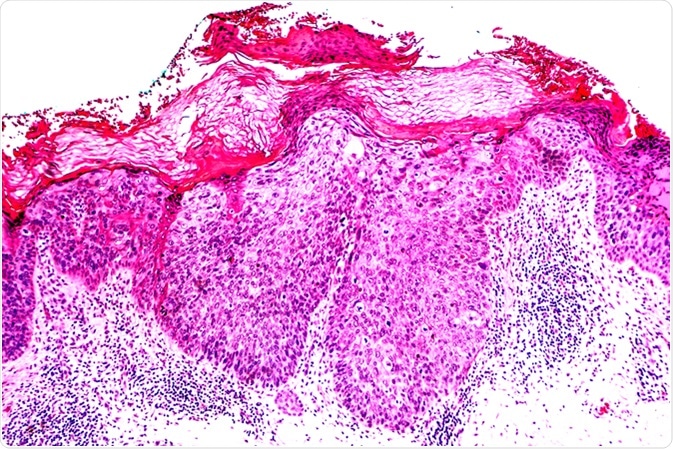By Jeyashree Sundaram, MBA
Bowen's disease is a skin condition that has continuous, slow-developing scaly-red patches. It is also known as squamous cell carcinoma in situ (SCC in situ), and is a non-invasive and presiding form of intraepidermal carcinoma. However, it has only a 10% chance of developing into SCC, a type of common skin cancer.
This condition was named after a dermatologist J. T. Bowen who first defined it in the year 1912. The occurrence of the condition is more frequent in elderly patients above the age of 50 years, in patients with poor wound healing abilities and in patients with several comorbidities such as diabetics. However, some youngsters are also diagnosed with this disease. Mostly women are more affected by this disease rather than men.

Cancer of Sun Damaged Skin: In squamous cell carcinoma in situ ("Bowen's disease"), malignant cells are confined to the epidermis, without invasion. Image Credit: David Litman / Shutterstock
Causes and Risk Factors
Although the specific cause of Bowen's disease is unknown, certain risk factors are expected to contribute in the development of this condition. People with fair skin, those who work outdoors and are exposed to the sun, and those who undergo treatment for immune disorder and usually take drugs are at a high risk to develop this disease.
People with HPV (Human papillomavirus) infection can also develop Bowen's disease. Earlier injury to skin that has scarred tissue may also lead to the development of this condition, particularly at that area. In rare cases, people with skin inflammation such as eczema might also develop Bowen's disease.
Signs and Symptoms
Generally, Bowen's disease occurs as a red, scaly patch in the locations of the body that are exposed to direct UV radiations emerging from the sun. The edges of each spot are different from normal skin and are irregular in shape. This disease has no symptoms and, hence, might be neglected. Bowen's disease, even though affects any pars of the body, mostly occurs at the lower leg. In some instances, the spots can cause irritation, while in others they may become sore and begin to bleed.
Diagnosis
This disease is often mistaken for other skin diseases such as psoriasis and eczema due to their overlapping side effects such as itchiness, ooziness and formation of flaky skin. Bowen's disease is often overlooked because it is asymptomatic. Generally, it can be diagnosed through a regular skin examination.
Diagnosis tests include the following methods:
- Physical examination
- Patient’s medical history
- Biopsy of skin lesions is generally examined under microscope. This biopsy sample can distinguish Bowen's disease from other types of skin disorders. The sample should be taken correctly to eliminate squamous cell carcinoma, an invasive skin disorder to differentiate from Bowen's disease.
Treatment
Bowen's disease can be cured by various treatments options such as:
- Cryosurgery: The dermatologist conducts this surgery to remove lesions using extreme cold conditions. This treatment has a 90% success rate.
- Curettage: This treatment includes scraping of lesions from the skin with the help of a curette. Cauterization is then performed to treat the base of the affected skin in which the skin is burnt slightly with electric current. Dermatologists perform this treatment with a 90% success rate.
- Photodynamic therapy (PDT): in this therapy, a PDT light is used to eliminate the lesions. A 60%–80% success rate is achieved by the specialist when treated with this method.
- Topical creams: A few creams such as imiquimod and 5-fluorouracil are also used to destroy the cells of skin lesions. This has the same success rate as PDT.
- Surgery: The general procedure includes cutting out of lesions and suturing the skin. This treatment has a success rate of 100% but with a major drawback of leaving a surgical scar.
- Radiation therapy: The lesions of the skin are treated with X-rays; this technique is not widely used as the healing process is much difficult.
Skin Cancer What is Bowens disease
Prognosis
There are multiple treatment procedures for Bowen's disease; however, the chances of recurrence are approximately one in ten. Hence, a routine follow-up is required to check for signs of reappearance. Additional treatment may be suggested if this recurrence happens.
The prognosis of people with Bowen's skin condition is generally good. The majority of people who are treated and completely recovered from Bowen's disease do not have any chances of developing a skin cancer.
Prevention
As exposure to sun is the fundamental risk factor for the development of Bowen's disease, reducing the exposure during the summer months is highly recommended for the prevention of this condition.
A few steps that can be followed to prevent Bowen's disease are:
- Staying in the shade or indoors as much as possible, from 11 am to 3 pm.
- To cover the skin with clothes and a hat with a wide-brim whenever in sunshine.
- Application of sunscreen lotions like SPF (sun protection factor) 15 and SPF 30 has great protection from UV radiation.
Further Reading
Last Updated: Feb 26, 2019